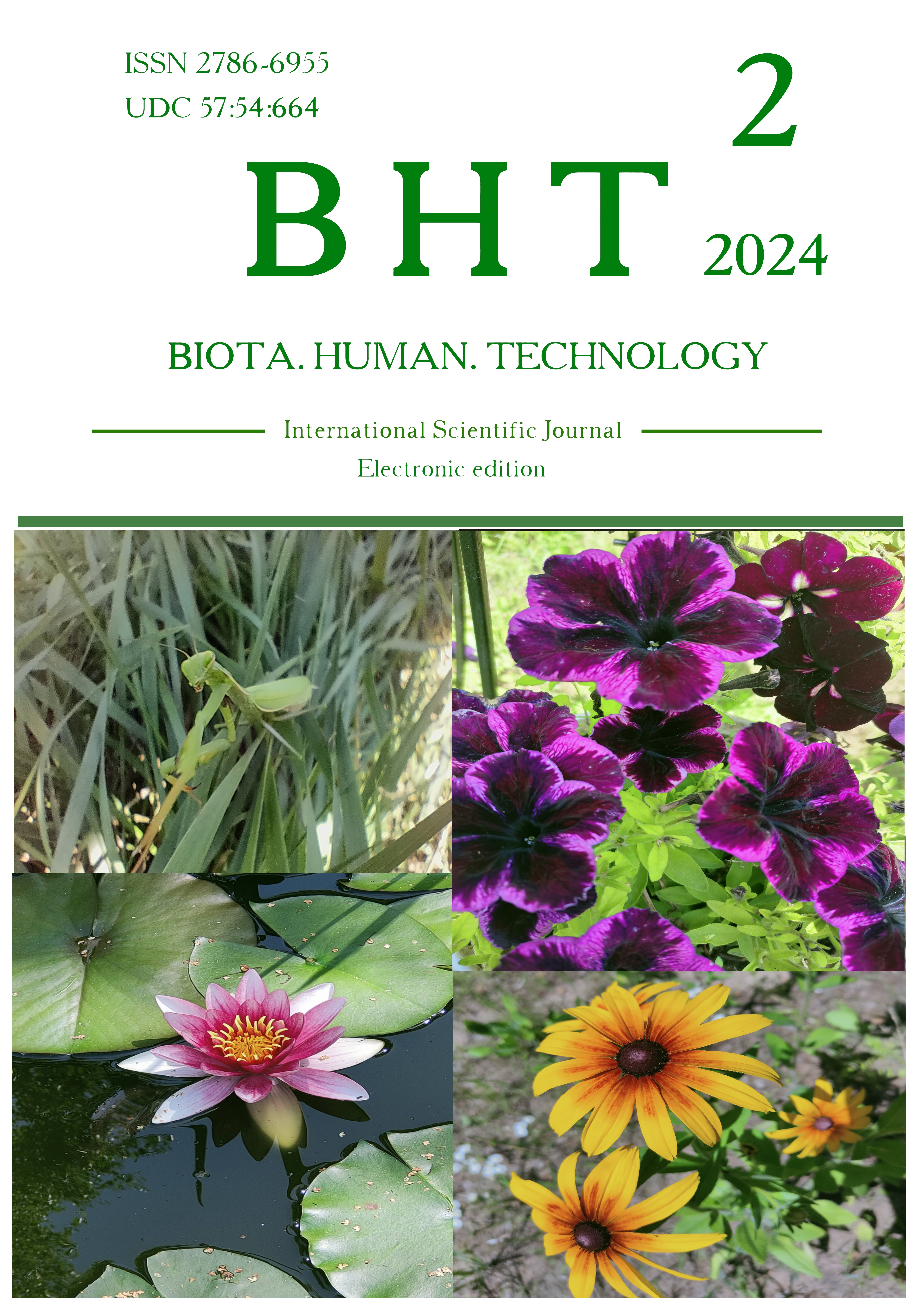ANALYSIS OF THE ADVENTIVE FRACTION OF THE FLOODWATER OF THE DNIPR RIVER IN THE BOUNDARIES OF THE NORTHERN STEPPE
DOI:
https://doi.org/10.58407/bht.2.24.2Keywords:
alien species, floodplain, archaeophyte, neophyte, anthropogenic transformationAbstract
The aims of the study. Provide a list and conduct an analysis of the adventitious fraction of the flora of vascular plants of the floodplain of the Dnipro River within the Northern Steppe.
Methodology. Research was carried out using general botanical methods of collection, herbarium, and species identification. When studying the flora of reservoirs, special hydrobotanical methods were used. The species names of the studied flora are given according to Mosyakin & Fedoronchuk (1999). The analysis of the adventitious fraction was carried out according to the time of deposition - archaeophytes, neophytes and the degree of naturalization - spontaneous, naturalized (Richardson, 2000). The analysis is based on the Kornás classification (Kornás, 1968).
Scientific novelty. For the first time, a list of adventive species of vascular plants of the floodplain of the Dnipro River within the Northern Steppe is provided. Its analysis was carried out according to the time of introduction and the degree of naturalization.
Conclusions. As a result of the research, it was established that the adventitious flora of vascular plants of the Dnipro River floodplain within the Northern Steppe is characterized by a significant number of adventives - 175 species, compared to the adventive flora of the Northern Steppe Prydniprovya - 357 species (Baranovski et al., 2023). This indicates a significant anthropogenic and climatic influence on the vegetation cover of this region. According to the time of introduction of the allochthonous element to the studied territory, it is divided into two groups: archaeophytes - 94 species (35.7%) and neophytes - 169 species (64.3%). According to the degree of naturalization, the species are distributed as follows: naturalized archaeophytes - 73 species (27.8%), naturalized neophytes - 75 species (28.5%), spontaneous archaeophytes - 21 species (8.%), spontaneous neophytes - 94 species (35 .7%). Among the represented flora of the adventitious fraction, the primary range of most species is Mediterranean - 73 species (27.8%), Asian - 55 species (21%) and North American - 52 species (19.8%). Other species have the following primary range: European – 24 species (9.1%), Irano-Turanian – 17 species (6.5%), Mediterranean-Irano-Turanian – 16 species (6%), range of unknown origin – 7 species (2.7%), South American - 7 species (2.7%) and the area of anthropogenic origin - 3 species (1.1%).
Downloads
References
Baranovski, B. A., Karmyzova, L. A., Dubуna, D. V., & Shevera, M. V. (2023). Bioecology and hemeroby of flora species in the Northern Steppe Dnipro Region. Biosystems Diversity, 31(4), 548–577. https://doi.org/10.15421/012365
Katanskaya, V. M. (1981). Higher aquatic vegetation of the continental reservoirs of the USSR. Leningrad: Nauka (in Russian)
Катанская В. М. Высшая водная растительность континентальных водоемов СССР. Ленинград: Наука, 1981. 185 с.
Kornás, J. A. (1968). Geographical-historical classification of synanthropic plants. Materialy Zakladu Fitosocjologii Stosowanej Uniwersytetu Warszawskiego, 25, 33–41.
Mosyakin, S. L., & Fedoronchuk, M. M. (1999). Vascular plants of Ukraine. A nomenclatural checklist. National Academy of Sciences of Ukraine, Kyiv
Protopopova, V., & Shevera, M. (2019). Invasive species in the flora of Ukraine. I. The group of highly active species. GEO&BIO, 17, 116–135. https://doi.org/10.15407/gb.2019.17.116 (in Ukrainian)
Протопопова В. В., Шевера М. В. Інвазійні рослини у флорі України. І. Група високоактивних видів. GEO&BIO, 2019. Вип. 17. C. 116-135.
Protopopova, V. V. (1991). Synanthropic flora of Ukraine and ways of its development. Naukova Dumka, Kyiv (in Russian)
Протопопова В. В. Синантропная флора Украины и пути её развития. Киев: Наукова думка, 1991. 204 с.
Richardson, D. M., Pyšek, P., Rejmánek, M., Barbour, M. G., Panetta, F. D., & West, C. J. (2000). Naturalization and invasion of alien plants: Concepts and definitions. Diversity and Distributions, 6, 93–107. https://doi.org/10.1046/j.1472-4642.2000.00083.x
Schindler, S., O’Neill, F., Biró, M., Damm, C., Gasso, V., Kanka, R., Sluis, T., Krug, A., Lauwaars, S. G., Sebesvari, Z., Pusch, M., Baranovski, B., Ehlert, T., Neukirchen, B., Martin, J. R., Euller, K., Mauerhofer, V., & Wrbka, T. (2016). Multifunctional floodplain management and biodiversity effects: A knowledge synthesis for six European countries. Biodivers. Conserve., 25, 1349–1382. https://doi.org/ 10.1007/s10531-016-1129-3
Serebryakov, I. G. (1964). Life forms of higher plants and their study. Publishing House of the Academy of Sciences of the USSR (in Russian)
Серебряков И. Г. Жизненные формы высших растений и их изучение. Полевая геоботаника. Москва: Издательство АН СССР, 1964. Т. 3. С. 146–205.
Downloads
Published
How to Cite
Issue
Section
License
Copyright (c) 2024 Ліна Кармизова

This work is licensed under a Creative Commons Attribution 4.0 International License.

